公共空间中的雕塑
1. 公共空间雕塑的历史:从古典雕像到当代艺术
公共空间中的雕塑经历了数个世纪的演变,逐渐承载了审美、政治与精神的价值。
古代与中世纪:公共雕塑往往具有宗教或纪念意义。在古希腊,雅典娜·帕特农神像等雕塑象征神明与城邦理想。中世纪时期,大教堂上的雕塑(如石像鬼与圣徒)旨在教化与震撼信众。
文艺复兴与古典时代:雕塑成为权力的象征工具。如马库斯·奥勒留骑马雕像或后来凡尔赛的路易十四雕像,表达了权威与荣耀。
现代时期:随着美、法等国革命的兴起,公共纪念雕塑开始具有民主色彩,自由女神像(1886年)即为一例。
当代时期:20世纪以来,雕塑打破具象传统,趋向抽象与互动。例如亚历山大·考尔德的动态雕塑或阿尼什·卡普尔的作品,都强调公众参与与感知体验。
2. 公共委托创作的政治与社会意义
公共雕塑常常反映其所处时代的社会紧张关系:
政治工具:有时公共艺术成为宣传媒介。如苏联时期列宁雕像,旨在塑造国家神话。
争议与抗议:雕塑也可能成为争议焦点。近年来,人们呼吁拆除与奴隶制度相关的雕像(如塞西尔·罗兹),显示出雕塑可成为历史矛盾的象征。
包容与参与:如今的公共艺术倾向于协作与民主化,试图呈现多元身份,如伦敦特拉法加广场的第四基座计划(4th Plinth)。
3. 材料与持久性的角色
公共雕塑的材料选择不仅关乎实用性,也具有审美与象征意义:
耐久性:古典纪念雕塑多用青铜或石材,旨在经受时间考验。
创新材料:当代雕塑探索非传统材料,如工业金属、玻璃、塑料与LED。例子:奥拉维尔·埃利亚松的灯光装置。
环境因素:生态议题影响创作,部分作品采用可降解材质,或嵌入生态系统中,如贾森·德凯尔斯·泰勒的海底雕塑。
互动性:现代材料赋予作品参与性,如阿尼什·卡普尔在芝加哥的“云门”,观众可在镜面中融入作品。
4. 公共空间的知名雕塑实例
自由女神像(巴托尔迪,1886年):象征美国的解放与欢迎。
妈妈(路易丝·布尔乔亚,1999年):巨大蜘蛛雕塑,安装于毕尔巴鄂、渥太华等地。
云门(阿尼什·卡普尔,2006年):芝加哥公共艺术互动象征。
大屠杀纪念碑石柱阵(彼得·艾森曼,柏林,2005年):抽象形式中的集体记忆。
七座魔法山(乌戈·朗迪农,美国加州,2016年):现场采集的岩石堆叠与彩绘装置。
5. 为什么应避免在公共空间中使用过于挑衅的雕塑?
公共雕塑面向所有人,因此其内容应有所节制,理由如下:
尊重文化多样性与敏感性
公共空间由价值观不同的群体共享,过于挑衅的作品可能被视为对集体规范或特定族群的冒犯。
公共空间的社会功能
公众普遍期待公共艺术有助于和谐与共融。冒犯性内容可能激起社会矛盾,反而削弱其文化价值。
制度背景
许多公共雕塑由政府机构批准或资助,相关争议会引发政治压力,损害机构声誉。
破坏风险
有争议的作品容易成为破坏目标,降低艺术影响力并提高维护或替换成本。
案例:保罗·麦卡锡《树》
2014年,美国艺术家保罗·麦卡锡在巴黎旺多姆广场安装了一件24米高的充气雕塑《树》。该作品因形状被公众联想为性用品(如肛塞),引发巨大争议。社交媒体与主流媒体的反应强烈,有人认为这是对巴黎文化的冒犯。数日后,雕塑被破坏并放气。麦卡锡本人也遭一名路人袭击,被指控“败坏公共道德”。该事件凸显出艺术挑衅与公众期待之间的张力。
6. 结论:一种必要的平衡
虽然挑衅是艺术反思的有效工具,公共雕塑却需特别考虑社会与文化语境。其影响超越艺术家的个人表达,直接影响市民日常生活。因此,公共艺术的展出是一种由艺术家、机构与社会共同承担的责任。
公共空间中的场景模拟
Projections in Public Spaces
部分雕塑作品在公共空间中的嵌入式展示选辑
A selection of projections for sculptures in public spaces

From the ArtWork :
伏羲再生:胜利的沉默. 第008
Reloaded Fuxi. The Silence of Victory. V008
2025
Body : Bronze
DNA Helix : Polished Steel
Total Height : Dimensions Variable

From the ArtWork :
伏羲再生:胜利的沉默. 第004
Reloaded Fuxi. The Silence of Victory. V004
2025
Body : Bronze
Game Controller : Polished Steel
Total Height : Dimensions Variable

From the ArtWork :
伏羲再生:胜利的沉默. 第007
Reloaded Fuxi. The Silence of Victory. V007
2025
Body : Bronze
Base : Polished Steel
Total Height : Dimensions Variable

From the ArtWork :
嫦娥再生:胜利的沉默 · 第005
Reloaded Chang’e. The Silence of Victory. V005
2025
Body : Bronze
Rock : Bronze + Painted Finish
Base : Polished Steel
Total Height : Dimensions Variable
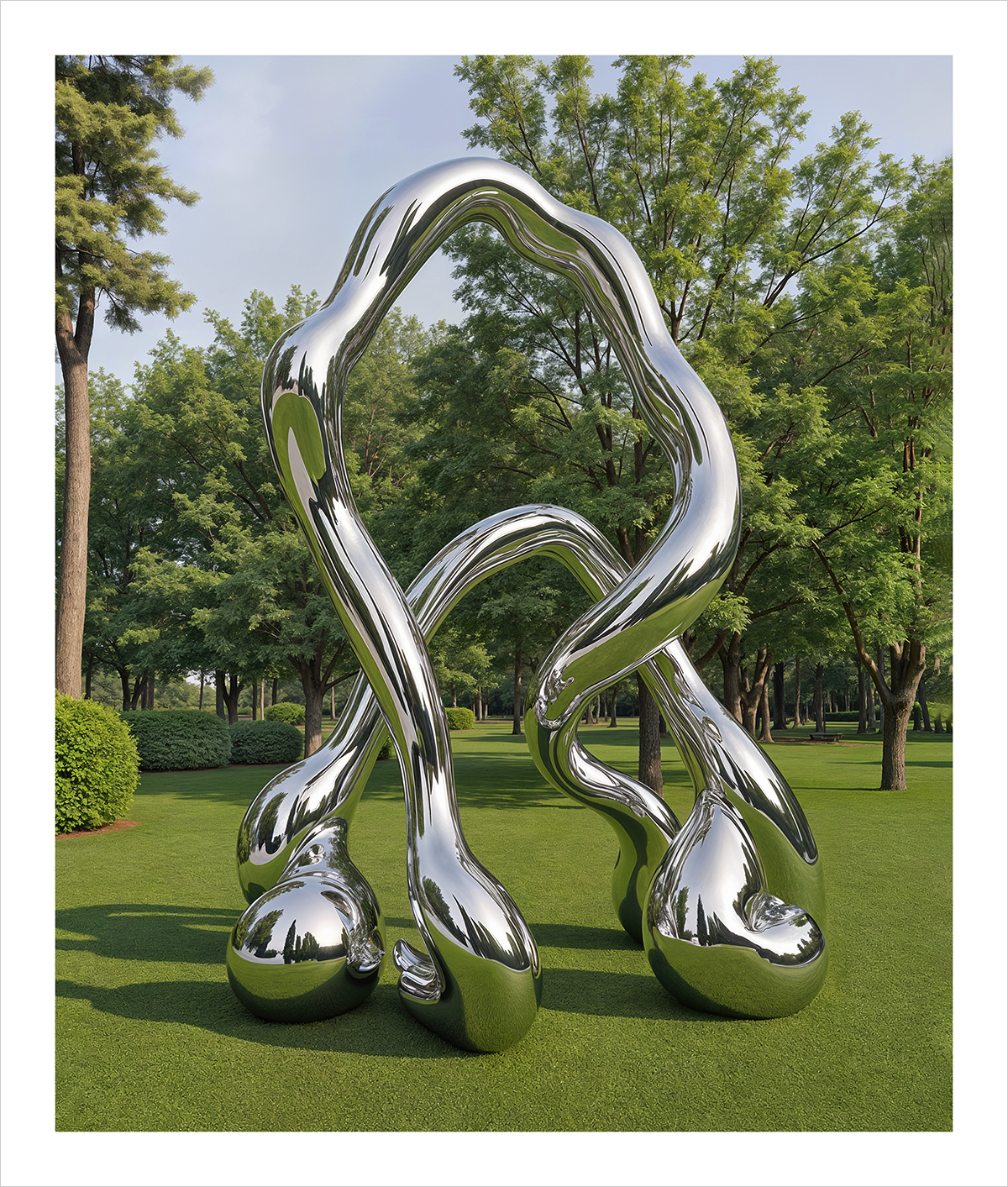
From the ArtWork :
重构之形:存在的沉默
Reloaded Form. The Silence of Presence
2025
Sculpture : Polished Steel
Total Height : Dimensions Variable
适用于公共空间的雕塑作品
Sculptures Available for Public Spaces
伏羲再生
Reloaded Fuxi

From the ArtWork :
伏羲再生:胜利的沉默. 第001
Reloaded Fuxi. The Silence of Victory. V001
2025
Body : Bronze. Height 170 cm
Rock : Bronze + Painted Finish. Height 90 cm
Base : Polished Steel. Height 25 cm
Total Height : 285 cm

From the ArtWork :
伏羲再生:胜利的沉默. 第002
Reloaded Fuxi. The Silence of Victory. V002
2025
Body : Bronze. Height 170 cm
Rock : Bronze + Painted Finish. Height 90 cm
Base : Polished Steel. Height 25 cm
Total Height : 285 cm

From the ArtWork :
伏羲再生:胜利的沉默. 第003
Reloaded Fuxi. The Silence of Victory. V003
2025
Body : Bronze. Height 170 cm
Rock : Bronze + Painted Finish. Height 90 cm
Base : Polished Steel. Height 25 cm
Total Height : 285 cm

From the ArtWork :
伏羲再生:胜利的沉默. 第004
Reloaded Fuxi. The Silence of Victory. V004
2025
Body : Bronze. Height 170 cm
Game Controller : Polished Steel. Height 60 cm
Total Height : 230 cm
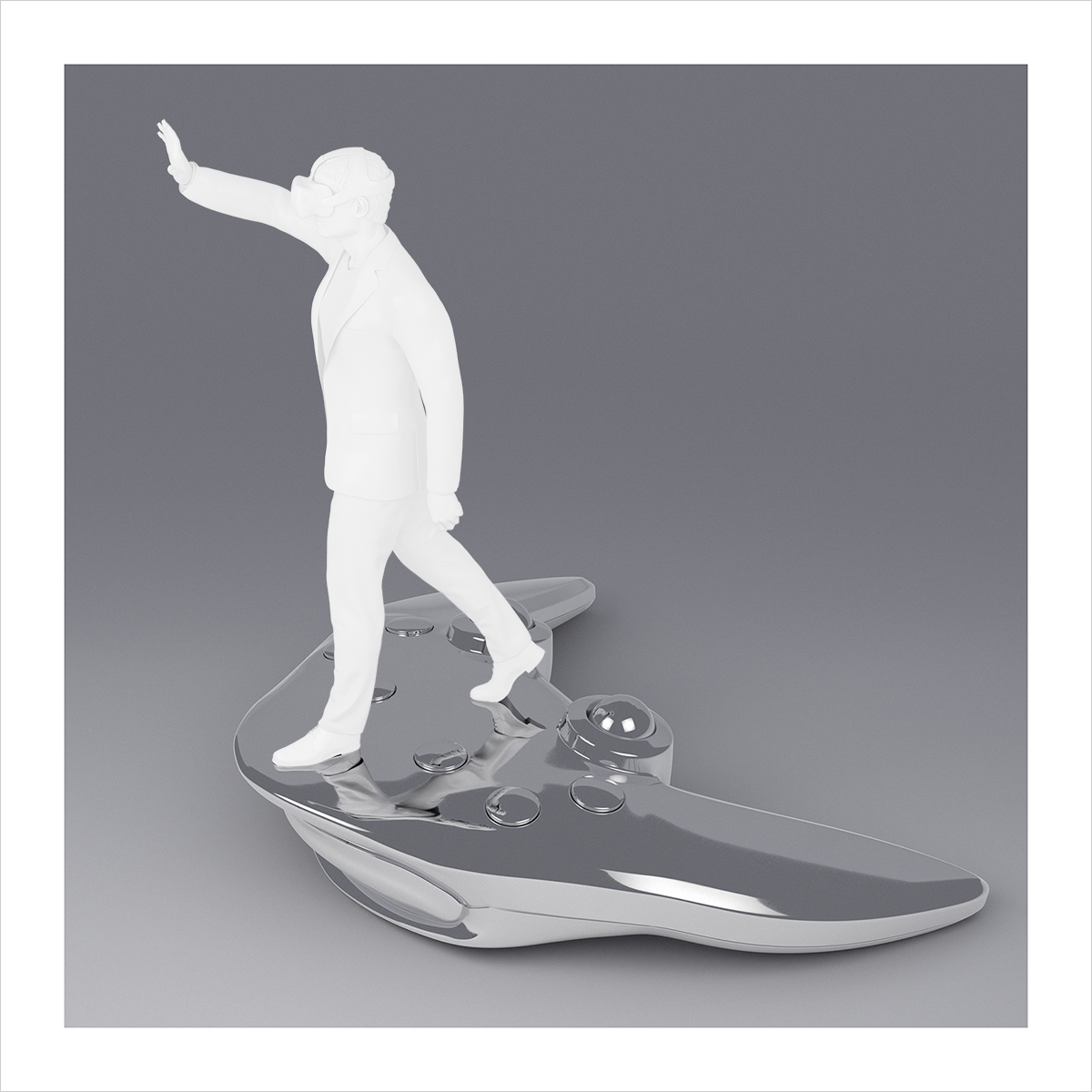
From the ArtWork :
伏羲再生:胜利的沉默. 第004
Reloaded Fuxi. The Silence of Victory. V004
(Detail : Game Controller)
2025
Body : Bronze. Height 170 cm
Game Controller : Polished Steel. Height 60 cm
Total Height : 230 cm

From the ArtWork :
伏羲再生:胜利的沉默. 第005
Reloaded Fuxi. The Silence of Victory. V005
2025
Body : Bronze. Height 170 cm
Game Controller : Polished Steel. Height 60 cm
Total Height : 230 cm

From the ArtWork :
伏羲再生:胜利的沉默. 第006
Reloaded Fuxi. The Silence of Victory. V006
2025
Body : Bronze. Height 170 cm
Game Controller : Polished Steel. Height 60 cm
Total Height : 230 cm

From the ArtWork :
伏羲再生:胜利的沉默. 第007
Reloaded Fuxi. The Silence of Victory. V007
2025
Body : Bronze
Base : Polished Steel
Total Height : Dimensions Variable

From the ArtWork :
伏羲再生:胜利的沉默. 第008
Reloaded Fuxi. The Silence of Victory. V008
2025
Body : Bronze
DNA Helix : Polished Steel
Total Height : Dimensions Variable

From the ArtWork :
伏羲再生:胜利的沉默. 第009
Reloaded Fuxi. The Silence of Victory. V009
2025
Body : Bronze
DNA Helix : Polished Steel
Total Height : Dimensions Variable

From the ArtWork :
伏羲再生:胜利的沉默. 第010
Reloaded Fuxi. The Silence of Victory. V010
2025
Body : Bronze
DNA Helix : Polished Steel
Total Height : Dimensions Variable
重构之形
RELOADED FORM
重构之形
雕塑不再是形象,也不再是身体,而是它的形式记忆。通过《重构之形》这一为公共空间构思的雕塑系列,我延续了身体消解的概念,并以数字结构替代之,使其成为自主且脱离叙事的存在。
这些有机雕塑由弯曲的线条、扭转与光滑的体块构成,仿佛人体已被转译为结构,脱离了活体物质,却承载着记忆。
Reloaded Form
The sculpture is no longer a figure, nor a body, but its formal memory. With Reloaded Form, a series of sculptures conceived for public space, I continue the concept of the body’s dissolution and its replacement by digital structures, autonomous and free from any form of narration.
These organic sculptures are composed of curved lines, torsions and smooth masses, as if the human body had been translated into structure, released from its living matter but charged with memory.

From the ArtWork :
重构之形:存在的沉默 · 第001
Reloaded Form. The Silence of Presence. V001
2025
Sculpture : Polished Steel
Total Height : Dimensions Variable
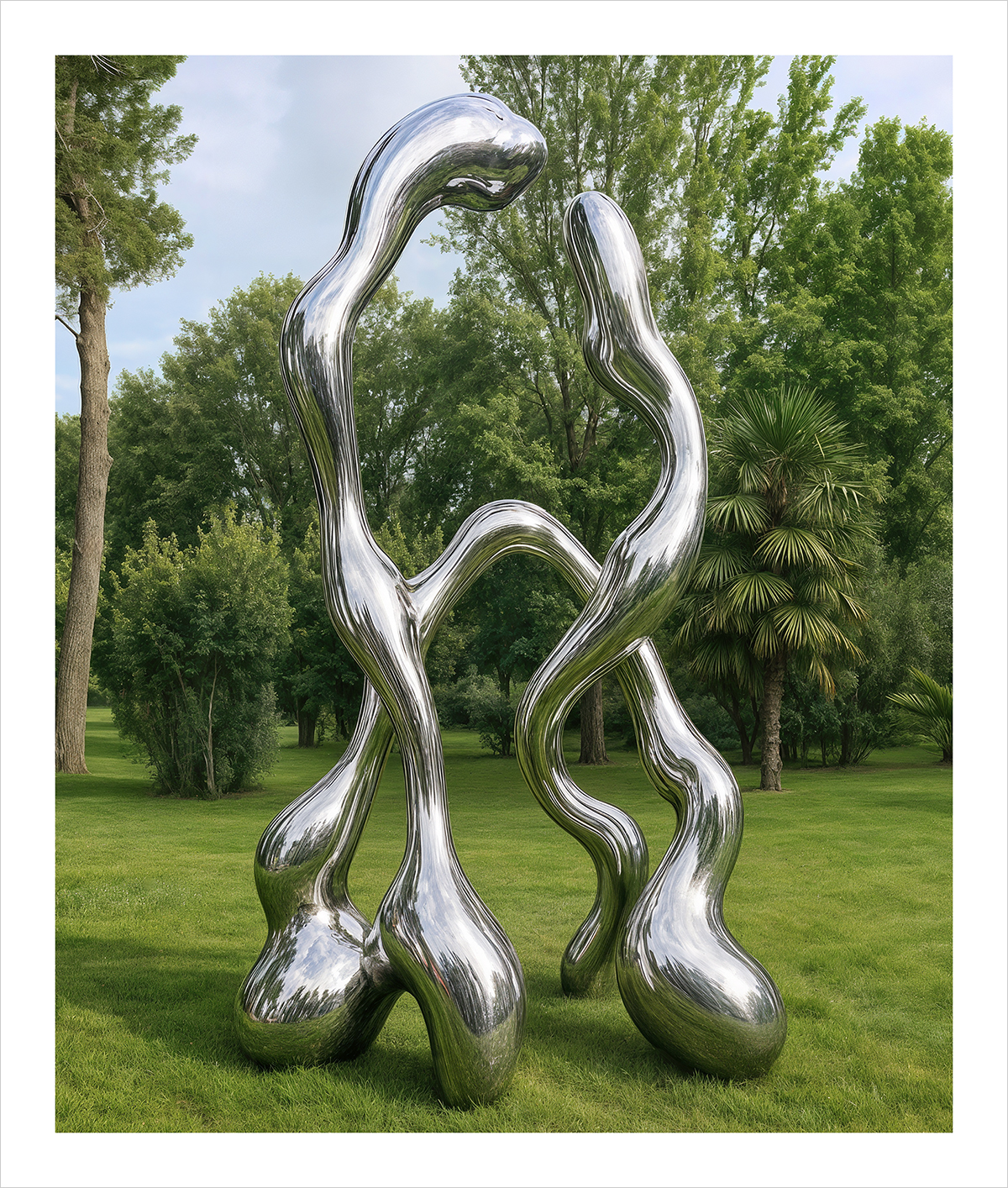
From the ArtWork :
重构之形:存在的沉默 · 第002
Reloaded Form. The Silence of Presence. V002
2025
Sculpture : Polished Steel
Total Height : Dimensions Variable
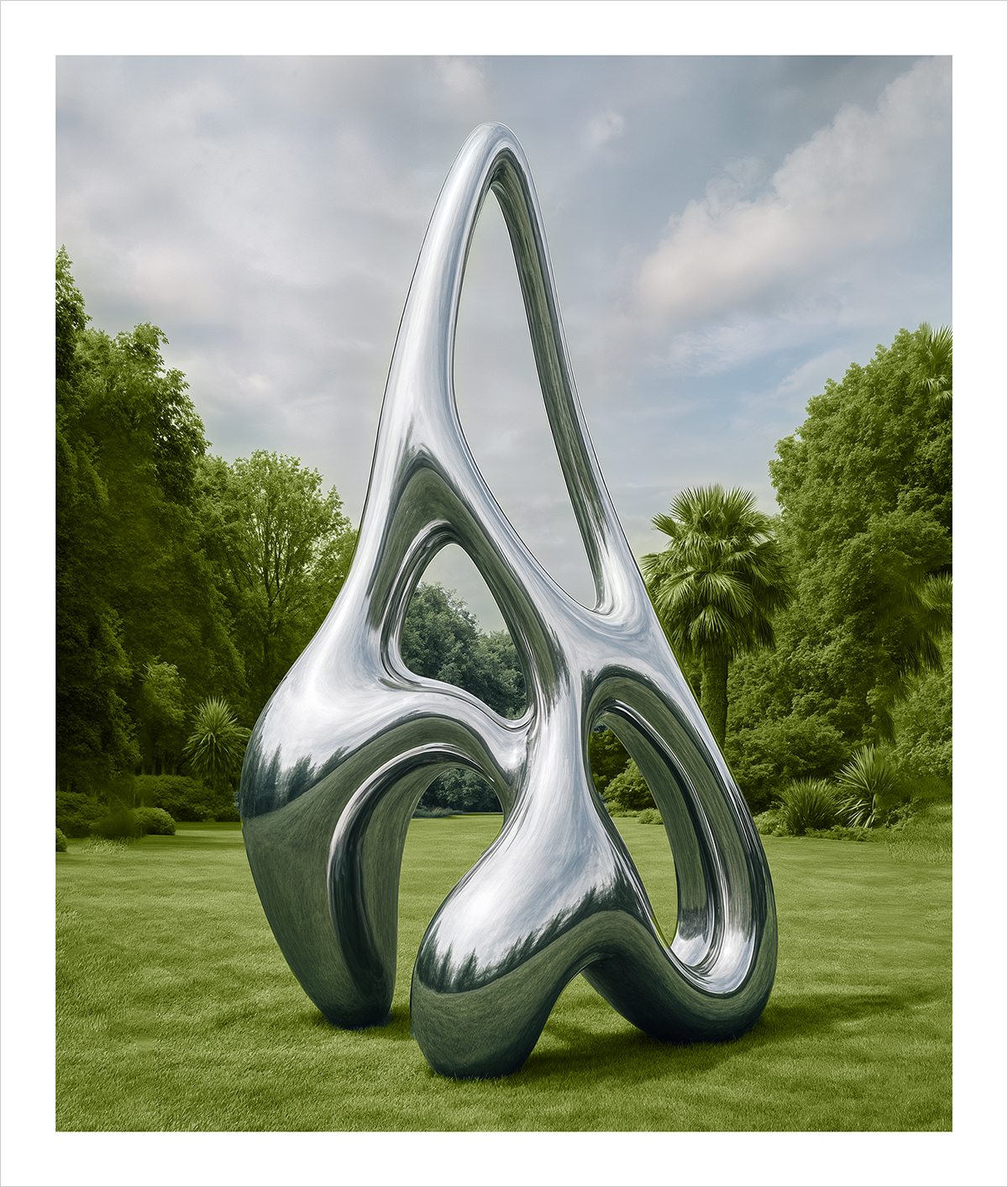
From the ArtWork :
重构之形:存在的沉默 · 第003
Reloaded Form. The Silence of Presence. V003
2025
Sculpture : Polished Steel
Total Height : Dimensions Variable
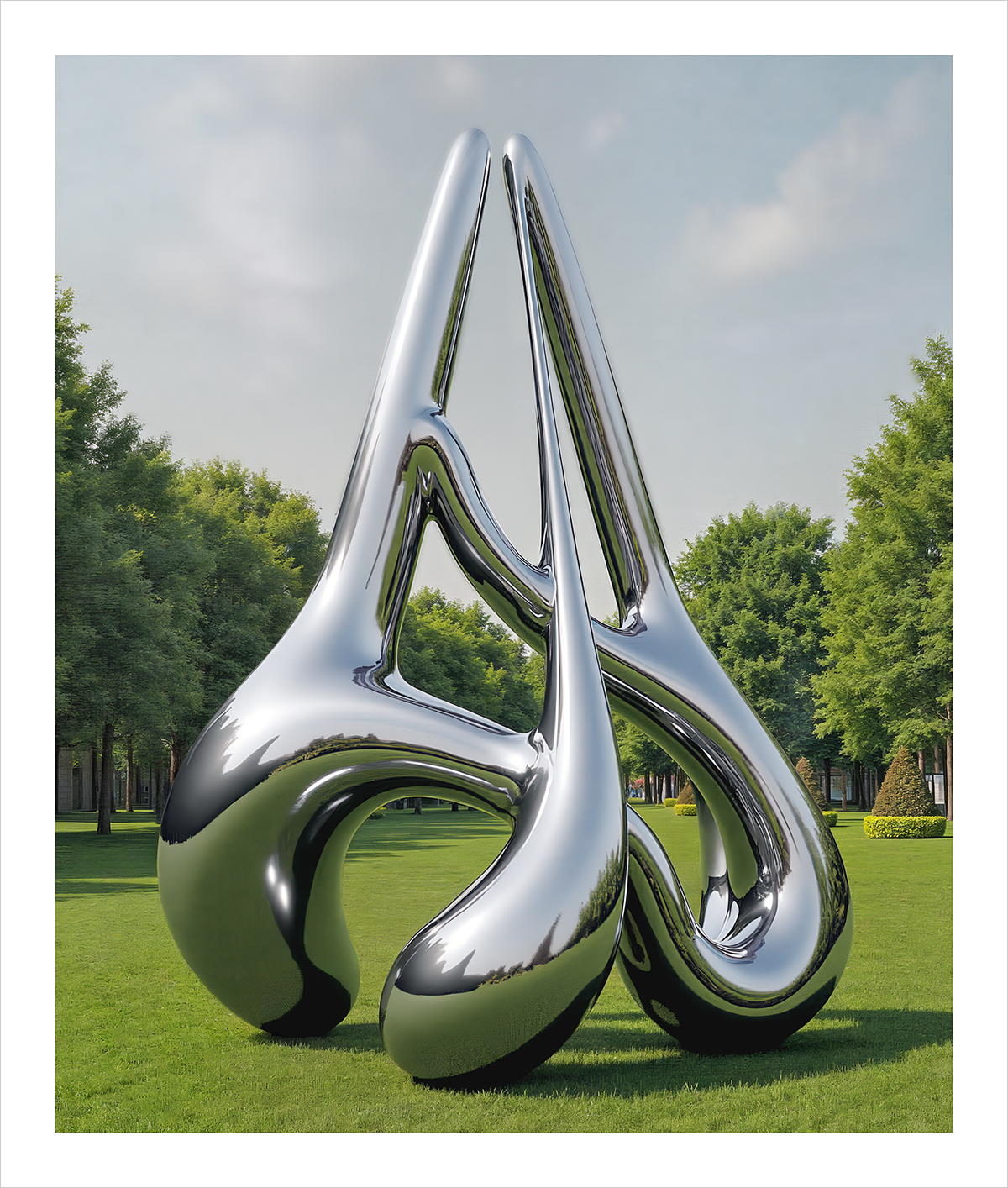
From the ArtWork :
重构之形:存在的沉默 · 第004
Reloaded Form. The Silence of Presence. V004
2025
Sculpture : Polished Steel
Total Height : Dimensions Variable
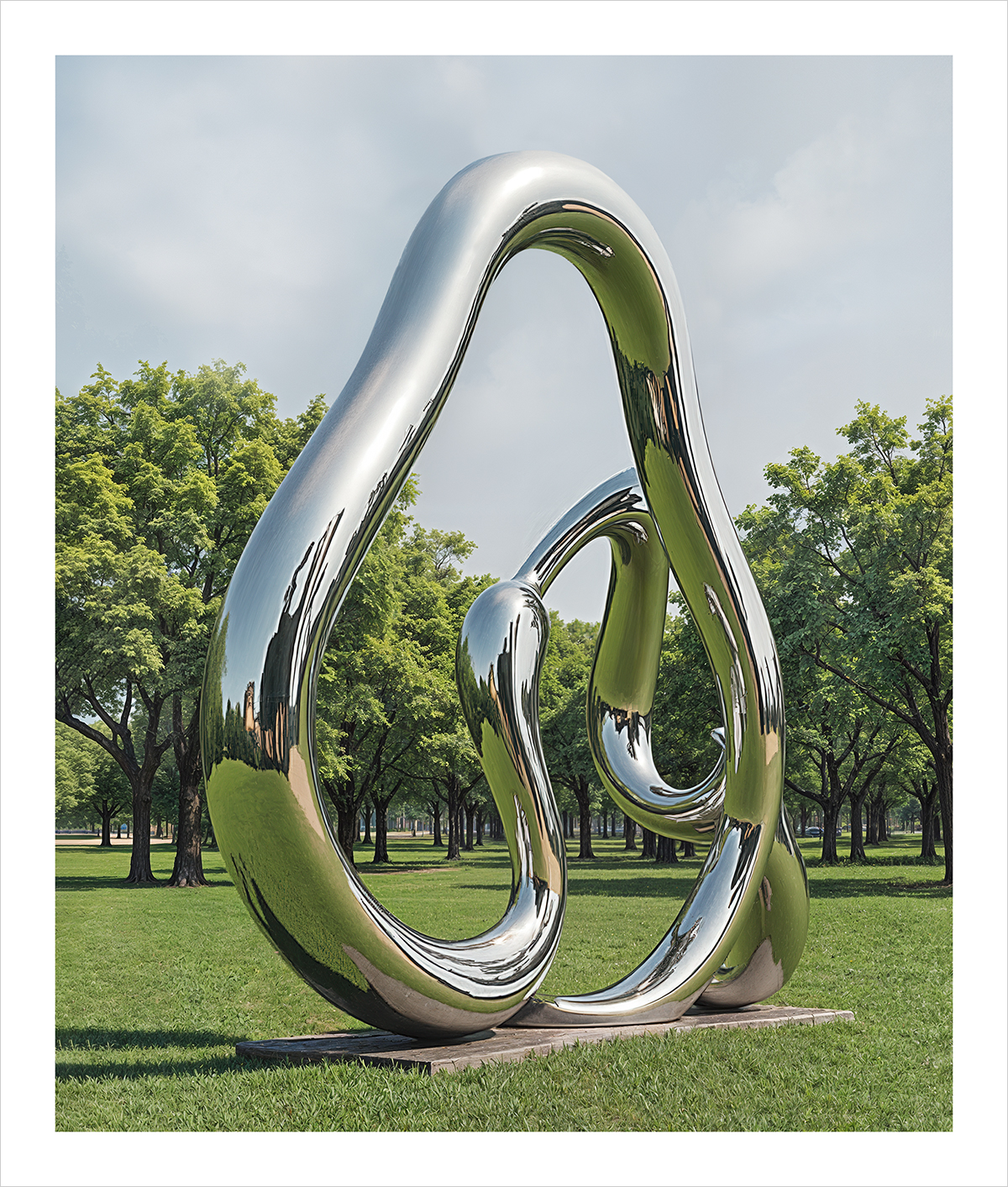
From the ArtWork :
重构之形:存在的沉默 · 第005
Reloaded Form. The Silence of Presence. V005
2025
Sculpture : Polished Steel
Total Height : Dimensions Variable
嫦娥再生:胜利的沉默
Reloaded Chang’e
嫦娥再生
在《嫦娥再生》中,这位月神,如同一次光之流放的回响,人类形态成为一场变异的沉默映照,展现出一个智人现实:庆祝其身份的多样性,介于生物记忆、新的建构与数字愿望之间。

From the ArtWork :
嫦娥再生:胜利的沉默 · 第001
Reloaded Chang’e. The Silence of Victory. V001
2025
Body : Bronze. Height 170 cm
Rock : Bronze + Painted Finish. Height 90 cm
Base : Polished Steel. Height 25 cm
Total Height : 285 cm

From the ArtWork :
嫦娥再生:胜利的沉默 · 第002
Reloaded Chang’e. The Silence of Victory. V002
2025
Body : Bronze. Height 170 cm
Rock : Bronze + Painted Finish. Height 90 cm
Base : Polished Steel. Height 25 cm
Total Height : 285 cm

From the ArtWork :
嫦娥再生:胜利的沉默 · 第003
Reloaded Chang’e. The Silence of Victory. V003
2025
Body : Bronze. Height 170 cm
Rock : Bronze + Painted Finish. Height 90 cm
Base : Polished Steel. Height 25 cm
Total Height : 285 cm

From the ArtWork :
嫦娥再生:胜利的沉默 · 第004
Reloaded Chang’e. The Silence of Victory. V004
2025
Body : Bronze. Height 170 cm
Rock : Bronze + Painted Finish. Height 90 cm
Base : Polished Steel. Height 25 cm
Total Height : 285 cm

From the ArtWork :
嫦娥再生:胜利的沉默 · 第005
Reloaded Chang’e. The Silence of Victory. V005
2025
Sculpture in Public Spaces
Body : Bronze
DNA Helix : Polished Steel
Total Height : Dimensions Variable

From the ArtWork :
嫦娥再生:胜利的沉默 · 第006
Reloaded Chang’e. The Silence of Victory. V006
2025
Sculpture in Public Spaces
Body : Bronze
DNA Helix : Polished Steel
Total Height : Dimensions Variable

From the ArtWork :
嫦娥再生:胜利的沉默 · 第007
Reloaded Chang’e. The Silence of Victory. V007
2025
Sculpture in Public Spaces
Body : Bronze
DNA Helix : Polished Steel
Total Height : Dimensions Variable
Sculpture in Public Spaces
1. The History of Sculpture in Public Spaces: From Classical Statuary to Contemporary Works
Sculptures in public spaces have evolved over centuries to embody aesthetic, political, and spiritual values.
Antiquity and the Middle Ages: Public sculptures were often religious or honorific. In ancient Greece, statues like Athena Parthenos embodied deities and civic ideals. During the Middle Ages, sculptures on cathedrals (e.g., gargoyles, saints) guided and impressed the faithful.
Renaissance and Classical Periods: Sculpture became a tool to glorify power. Equestrian statues, like that of Marcus Aurelius in Rome or later Louis XIV at Versailles, expressed authority and prestige.
Modern Era: With the rise of revolutions (American, French), public monuments took on a democratic dimension, exemplified by The Statue of Liberty (1886).
Contemporary Period: The 20th century saw a break with figurative traditions. Works became abstract or interactive, such as those by Alexander Calder (stabiles and mobiles) or Anish Kapoor, integrating public engagement into the experience.
2. The Political or Social Stakes of Public Commissions
Public sculptures often reflect the tensions of their time:
Political: Public commissions are sometimes tools of propaganda. Statues of leaders, such as Soviet monuments to Lenin, served to construct national myths.
Contestation: Sculptures can also be objects of debate. The contemporary movement to remove statues tied to slavery histories (e.g., those of Cecil Rhodes) shows how these works can crystallize historical tensions.
Inclusion and Participation: Today, public commissions tend to be more collaborative and democratic, aiming to represent diverse identities (e.g., 4th Plinth at Trafalgar Square).
3. The Role of Materials and Durability
The materials chosen for public sculptures respond to practical, aesthetic, and symbolic imperatives:
Durability: Sculptures made of bronze or stone, like classical monuments, were designed to withstand the test of time.
Innovation: Contemporary works explore less traditional materials (industrial metals, glass, plastics, LED). Example: the light installations by Olafur Eliasson.
Environment: Ecological concerns influence creation, with works designed to be biodegradable or integrated into ecosystems (e.g., the reef sculptures by Jason deCaires Taylor).
Interaction: Modern materials often enable interaction and participation, such as the reflective surfaces of Anish Kapoor’s Cloud Gate (Chicago).
4. Famous Examples in Public Spaces
The Statue of Liberty (Bartholdi, 1886): A symbol of emancipation and welcome in the United States.
Maman (Louise Bourgeois, 1999): A giant spider installed in public spaces like Bilbao or Ottawa.
Cloud Gate (Anish Kapoor, 2006): Sculpture emblem of interactive public art. Chicago.
The Stelae of the Holocaust Memorial (Peter Eisenman, Berlin, 2005): Abstraction and collective memory.
Seven Magic Mountains (Ugo Rondinone, Ivanpah Valley, California. 2016) – Installation of rocks found on site, painted and balanced, more or less precariously.
5. Why Avoid Overly Provocative Sculptures in Public Spaces?
Public sculptures, as creations accessible to everyone, reach a diverse audience. Several arguments justify a degree of restraint in their content:
Respect for Cultural Diversity and Sensitivities
Public spaces are shared by communities with varying values, beliefs, and traditions. A work that is too provocative may be perceived as an attack on collective norms or specific groups.
Social Function of Public Space
Public art is often expected to contribute to harmony and inclusion. Offensive or shocking sculptures could provoke social tensions instead of enriching communal spaces.
Institutional Context
Public sculptures are often commissioned or approved by public authorities, who are accountable to their citizens. Controversy can lead to political pressure and damage the reputation of the supporting institutions.
Risk of Vandalism or Rejection
A controversial work is often a target for vandalism, reducing its impact and increasing maintenance or replacement costs.
Example: Paul McCarthy’s Tree
In 2014, American artist Paul McCarthy created a monumental inflatable sculpture titled Tree, installed in Place Vendôme, Paris. The abstract work, representing a 24-meter green “tree,” quickly sparked outrage because many associated its shape with a sexual object (a butt plug). Reactions: The sculpture immediately caused a media and social media uproar, with some viewing it as an insult to the elegance and cultural heritage of Paris. The artwork was vandalized and deflated within days by opponents. McCarthy himself was physically attacked by a passerby, accusing him of corrupting public values. Consequences: The incident highlighted tensions between artistic provocation and public expectations of art in shared spaces. While some defended it as a bold artistic statement, others criticized it as disconnected from citizens.
6. Conclusion: A Necessary Balance
While provocation can be a powerful tool for reflection in art, public sculptures require particular attention to social and cultural contexts. Their impact goes beyond the artist’s intent, directly affecting the daily lives of citizens. In this sense, exhibiting art in public spaces demands a shared responsibility between artists, institutions, and society.
La Sculpture dans l’espace public
1. L’histoire des sculptures dans l’espace public : de la statuaire classique aux œuvres contemporaines
Les sculptures dans l’espace public ont traversé des siècles en incarnant des valeurs esthétiques, politiques et spirituelles.
Antiquité et Moyen Âge : La sculpture publique était souvent religieuse ou honorifique. Dans la Grèce antique, des statues comme Athéna Parthénos incarnaient les divinités et les idéaux civiques. Au Moyen Âge, les sculptures ornant les cathédrales (gargouilles, saints) guidaient et impressionnaient les fidèles.
Renaissance et période classique : La sculpture devient un outil pour glorifier le pouvoir. Les statues équestres, comme celle de Marc Aurèle à Rome ou plus tard de Louis XIV à Versailles, expriment l’autorité et le prestige.
Époque moderne : Avec l’avènement des révolutions (américaine, française), les monuments publics prennent une dimension démocratique, comme la Statue de la Liberté (1886).
Contemporain : Le 20e siècle voit une rupture avec la tradition figurative. Les œuvres deviennent abstraites ou interactives, comme celles d’Alexander Calder (stabiles mobiles) ou Anish Kapoor, intégrant le public dans l’expérience.
2. Les enjeux politiques ou sociaux liés à la commande publique
La sculpture publique est souvent le reflet des tensions de son époque :
Politique : Les commandes publiques sont parfois des outils de propagande. Des statues de dirigeants, comme les monuments soviétiques à Lénine, ont servi à construire des mythes nationaux.
Contestation : Les sculptures sont aussi des objets de débat. Le mouvement contemporain de déboulonnage de statues liées à l’histoire esclavagiste (par ex. les statues de Cecil Rhodes) montre comment ces œuvres peuvent cristalliser des tensions historiques.
Inclusion et participation : Aujourd’hui, les commandes publiques tendent à être plus collaboratives et démocratiques, visant à représenter des identités diverses (ex. : 4th Plinth à Trafalgar Square).
3. Le rôle des matériaux et de la durabilité
Les matériaux choisis pour les sculptures publiques répondent à des impératifs pratiques, esthétiques et symboliques :
Durabilité : Les sculptures en bronze ou en pierre, comme les monuments classiques, étaient conçues pour résister au temps.
Innovation : Les œuvres contemporaines explorent des matériaux moins traditionnels (métaux industriels, verre, plastiques, LED). Exemple : les installations lumineuses de Olafur Eliasson.
Environnement : Le souci de l’écologie influence la création, avec des œuvres biodégradables ou intégrées dans des écosystèmes (comme les sculptures “récifs” de Jason deCaires Taylor).
Interaction : Des matériaux modernes favorisent l’interaction et la participation, comme les surfaces réfléchissantes d’Anish Kapoor (Cloud Gate, Chicago).
4. Exemples célèbres dans l’espace public
La Statue de la Liberté (Bartholdi, 1886) – Symbole d’émancipation et d’accueil aux États-Unis.
Maman (Louise Bourgeois, 1999) – Une araignée géante installée dans des espaces publics comme à Bilbao ou Ottawa.
Cloud Gate (Anish Kapoor, 2006) – Sculpture emblème de l’art public interactif.
Les stèles du Mémorial de l’Holocauste (Peter Eisenman, Berlin, 2005) – Abstraction et mémoire collective.
Seven Magic Mountains (Ugo Rondinone, Ivanpah Valley, California. 2016) – Installation de rochers trouvés sur place, peints et disposés en équilibre, plus ou moins précairement.
5. Pourquoi éviter des sculptures trop provocantes dans le domaine public ?
Les sculptures dans l’espace public, en tant que créations accessibles à tous, touchent un public hétérogène. Plusieurs arguments justifient une certaine retenue dans leur contenu :
Respect de la diversité culturelle et des sensibilités
Les espaces publics sont partagés par des communautés aux valeurs, croyances et traditions variées. Une œuvre trop provocante pourrait être perçue comme une attaque contre des normes collectives ou des groupes spécifiques.
Fonction sociale de l’espace public
L’art public doit souvent contribuer à l’harmonie et à l’inclusion. Une sculpture offensante ou choquante pourrait provoquer des tensions sociales au lieu d’enrichir l’espace commun.
Contexte institutionnel
Les sculptures dans l’espace public sont souvent commandées ou approuvées par des autorités publiques, responsables devant leurs citoyens. La controverse peut entraîner des pressions politiques et nuire à la réputation des institutions qui les soutiennent.
Risques de vandalisme ou de rejet
Une œuvre controversée est souvent une cible pour des actes de vandalisme, ce qui réduit son impact et augmente les coûts de maintenance ou de remplacement.
Un exemple célèbre : Tree de Paul McCarthy
En 2014, l’artiste américain Paul McCarthy a créé une sculpture monumentale intitulée Tree, installée sur la Place Vendôme à Paris. Cette œuvre abstraite, représentant un arbre gonflable vert de 24 mètres, a rapidement suscité une controverse massive, car elle évoquait pour beaucoup un objet sexuel (un plug anal). Réactions : La sculpture a provoqué un tollé immédiat dans les médias et sur les réseaux sociaux, certains y voyant une insulte à l’élégance et au patrimoine culturel de Paris. L’œuvre a été vandalisée et dégonflée par des opposants au bout de quelques jours. Paul McCarthy lui-même a été agressé physiquement sur place, un passant l’accusant de corrompre les valeurs publiques. Conséquences : Cette affaire a mis en lumière les tensions entre la liberté artistique et les attentes du public vis-à-vis de l’art dans l’espace public.
Certains y ont vu une défense de la provocation artistique, tandis que d’autres ont dénoncé une déconnexion entre l’art contemporain et les citoyens.
6. Conclusion : Un équilibre nécessaire
Si la provocation peut être un outil puissant de réflexion dans l’art, les sculptures publiques nécessitent une attention particulière au contexte social et culturel. Leur impact ne se limite pas à l’intention de l’artiste, mais touche directement la vie quotidienne des citoyens. En ce sens, l’exposition dans l’espace public appelle à une responsabilité partagée entre les artistes, les institutions et la société.





































